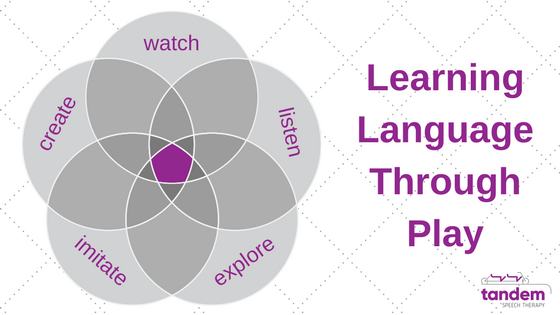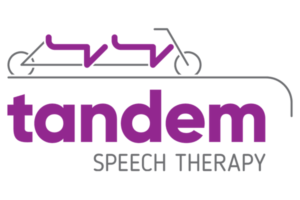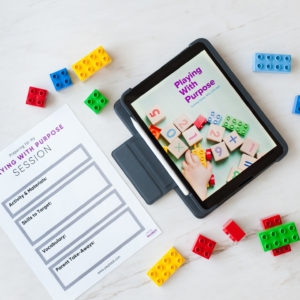
Maria Montessori once said, “Play is the work of the child.” From a young age, play is your child’s occupation. It is how children interact in and with their environment, discover their interests, and acquire and grow cognitive, motor, and social-emotional skills. When children play with other children and with adults, they learn to problem solve, how to get along with others, and how to use language and communicate effectively. They are learning language skills all the time!
As play and play skills develop, children develop. First, babies explore by putting everything in their mouth or perhaps by throwing toys. Next, kids build with blocks or play with cars and trains. They learn that objects have names, that you can play with them in a variety of ways, and that different toys and items can go together.
Whether the play is free and unstructured, or self-directed and very purposeful, it is a dynamic and lifelong process. As a parent, caregiver, or pediatric speech-language pathologist, each time you engage in these activities with children, you facilitate and reinforce the growth of skills across several areas of development.
In this post, we will break down the process of how children learn language through play.
1. Children watch.
Starting as an infant, your child watches your mouth as you talk. Your child watches your body language and facial expressions when you speak, communicate, and interact with others. Children also watch how you, siblings, and peers play with each other. All of this information–the movements of speech, expressions, and actions– get stored away for use later.
2. Children listen.
While your child is watching you, they are also listening. Listening begins early on too, from prenatal development, your child has been taking in sounds. Children listen to the variety of sounds we make, how we combine them into words, and the phrases or sentences we form. The more opportunity your child has to hear different words and types of words, the more words they will be able to access when they begin to imitate.
3. Children explore.
Watching and listening are key components of language development, but the exploration phase is when play becomes very important. During playtime, children explore and manipulate things around them. Your involvement and participation in your child’s play is also a key component of language development during this stage. Imagine playing with blocks with your child. As you put a block on top of your tower, you say “Block on.” When you clean up the blocks and place a block in its tub, you say “Block in.” Your child is now learning the words for ‘on’ and ‘in.’ The exploration phase happens throughout childhood, as does your important role in supporting language development.
4. Children imitate.
As your child watches and listens, they begin to imitate your actions and the sounds they hear around them. Early on, your child begins to mimic gross motor movements such as clapping and waving. This is a precursor to speech and language imitation and indicates an understanding of communication. Speech imitation starts with the coos that you can hear in your child’s first few months. Then, it progresses to babbling and later real words. All the time you spend in play with your child, narrating your actions and their actions, creates authentic language learning opportunities for your child.
5. Children create and formulate.
The skills your child has been working on and building–watching, listening, exploring/playing, and imitating–eventually come together. This combination allows your child to create and formulate their own words, sentences, and thoughts. Next, your child begins to use language for a purpose. Children use language to express wants and needs, share information, engage with peers, and ask questions. They create and formulate new ideas and sentences, using language to share and communicate. The more they do this, with you and with others, the more independent they become in their language and communicative abilities.
Now that you know how your child learns language through play, you are probably wondering how you can help your child expand their speech and language skills through play. Here are some easy to use resources, I have shared in the past, to look back on and begin today.
Want to learn more?
Start Playing With Purpose
Learn how to purposefully and intentionally interact with your child during play and help them increase opportunities for speech and language development with our Playing with Purpose book!










